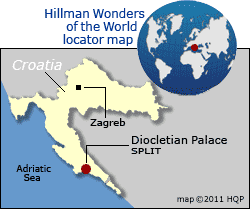Diocletian Palace
 Why the
Diocletian Palace
is special
Why the
Diocletian Palace
is specialIn the 4th Century AD, the Roman Emperor Diocletian built the fortified complex as his retirement residence.
Although this wonder has been drastically altered physically through the centuries, it is today the world's best-preserved Roman palace. And the multifarious alterations became a major tourist draw in themselves.
Top 3 Diocletian Palace must sees
Basement
This large barrel-vaulted subterranean rooms are imposing. Note: Some visitors miss out because they think that the space with the stalls selling jewelry and other items is the basement's famous attraction. It's not. Ask someone to direct you to the right place.
Cathedral
It was Diocletian's mausoleum before it was transformed into a church. The building conversion is ironic because the Roman emperor Diocletian was hell-bent on eradicating Christians.
Peristil Square
This sculpted courtyard is visually striking (see photo).
Diocletian Palace tips and insights
How to pronounce
Diocletian = dee-oh-klee-shun
When to come
The site's narrow passageways can become jammed in the summer with land and cruise tourists. Generally, the early morning or late afternoon hours are the least crowded. You can even come in the evenings (it never closes because people live there). The venue is relatively tourist-free then.
Size
The Diocletian Palace is large. It covers slightly over 30 hectares (8 acres).
Guide
This is the type of tourist site that is better explored with a human guide than on your own with a guidebook.
Site evolution
-
After the Diocletian Palace was abandoned, it sat virtually empty for several centuries.
- In the 7th century, thousands of local residents moved in to avoid the surging Barbarians. It became a city within a city, with its own dwellings and marketplaces.
- Over the next millennium, the occupants demolished and renovated many of the palace structures to suit their needs. This included creating houses and work spaces.
- Today, about several thousand people live within the 1,700-year-old palace walls. You will find a busy community comprising apartments, shops, galleries, bars, eateries, professional offices, and more.
Frankly, they are few if any that would interest the average traveler in the city of Split. It's essentially a one-attraction town.
Popular side trip
Just 27 kilometers (17 miles) away is the picturesque Trogir Old Town, one of Croatia's tourism jewels, and a Hillman Wonders medal winner. Many Split visitors make a day or overnight trip to this islet. You can reach it by road or boat.
Location in Croatia



